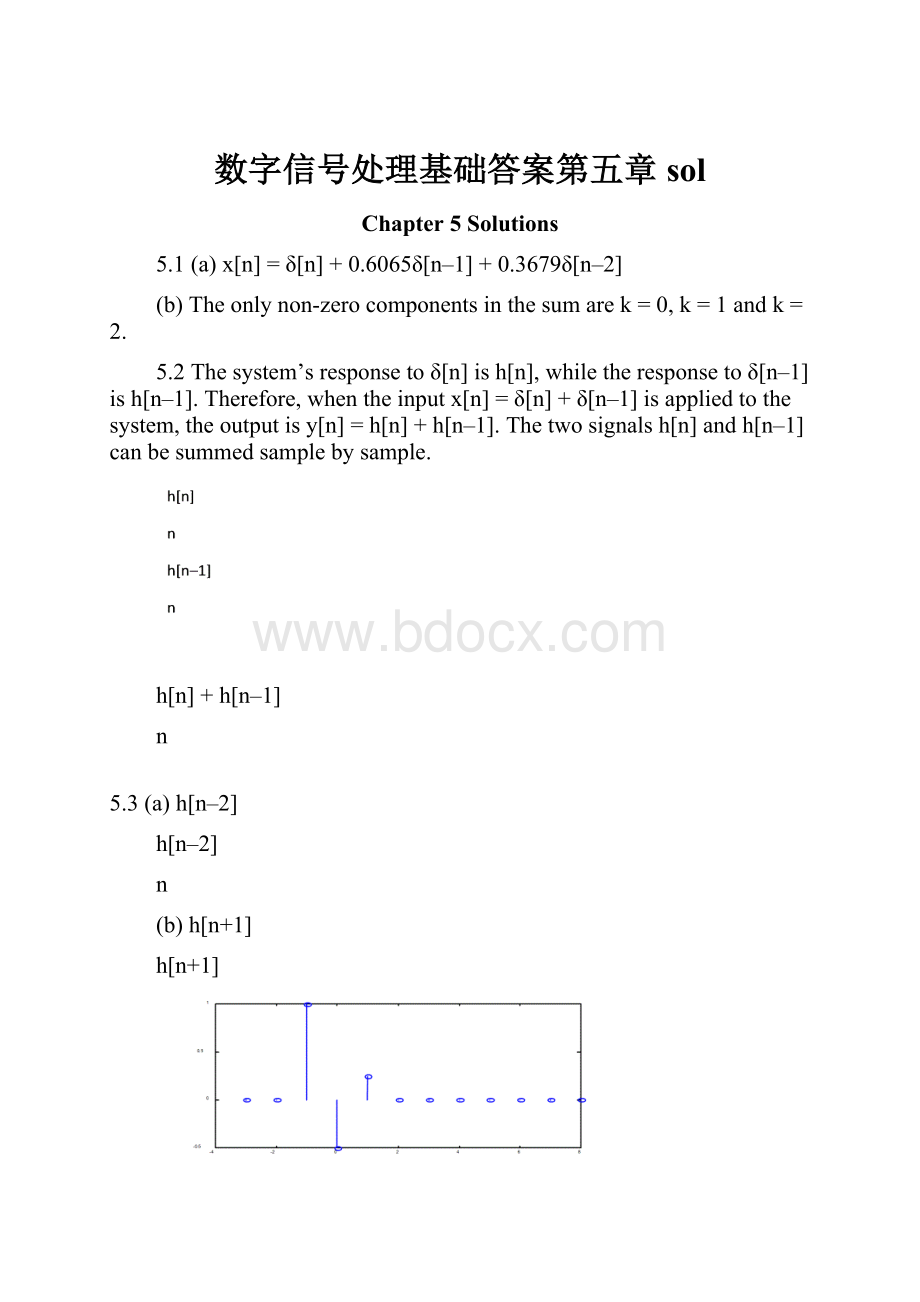数字信号处理基础答案第五章sol.docx
《数字信号处理基础答案第五章sol.docx》由会员分享,可在线阅读,更多相关《数字信号处理基础答案第五章sol.docx(21页珍藏版)》请在冰豆网上搜索。

数字信号处理基础答案第五章sol
Chapter5Solutions
5.1(a)x[n]=δ[n]+0.6065δ[n–1]+0.3679δ[n–2]
(b)Theonlynon-zerocomponentsinthesumarek=0,k=1andk=2.
5.2Thesystem’sresponsetoδ[n]ish[n],whiletheresponsetoδ[n–1]ish[n–1].Therefore,whentheinputx[n]=δ[n]+δ[n–1]isappliedtothesystem,theoutputisy[n]=h[n]+h[n–1].Thetwosignalsh[n]andh[n–1]canbesummedsamplebysample.
h[n]+h[n–1]
n
5.3(a)h[n–2]
h[n–2]
n
(b)h[n+1]
h[n+1]
n
(c)h[–n]
h[–n]
n
(d)h[3–n]
h[3–n]
n
5.4Startingwithn=0,theinputx[n]hasthesamplevalues0,–1and–2.Startingwithn=0,theimpulseresponseh[n]hasthesamplevalues1,2,3and4.Thesesamplesareinsertedintoaconvolutiontable.Beyondn=5,alloutputsarezero.Thisisadirectresultofthefinitelengthsoftheinputandimpulseresponsesignals.
x[k]
0
–1
–2
h[–k]
4
3
2
1
y[0]=0
h[1–k]
4
3
2
1
y[1]=–1
h[2–k]
4
3
2
1
y[2]=–4
h[3–k]
4
3
2
1
y[3]=–7
h[4–k]
4
3
2
1
y[4]=–10
h[5–k]
4
3
2
1
y[5]=–8
h[6–k]
4
3
2
1
y[6]=0
5.5(a)
x[k]
1
2
3
4
5
6
7
h[–k]
1
0
0
0
y[0]=0
h[1–k]
1
0
0
0
y[1]=0
h[2–k]
1
0
0
0
y[2]=0
h[3–k]
1
0
0
0
y[3]=1
h[4–k]
1
0
0
0
y[4]=2
h[5–k]
1
0
0
0
y[5]=3
h[6–k]
1
0
0
0
y[6]=4
(b)Theimpulseresponseh[n]=δ[n–k]delaysthesignalbyksteps.
5.6(a)Alloutputsamplesbeforen=0andaftern=8arezero.
x[k]
1
1
1
1
1
1
1
h[–k]
–0.2
–0.4
1
?
y[0]=1.0
h[1–k]
–0.2
–0.4
1
?
y[1]=0.6
h[2–k]
–0.2
–0.4
1
y[2]=0.4
h[3–k]
–0.2
–0.4
1
y[3]=0.4
h[4–k]
–0.2
–0.4
1
y[4]=0.4
h[5–k]
–0.2
–0.4
1
y[5]=0.4
h[6–k]
–0.2
–0.4
1
y[6]=0.4
h[7–k]
–0.2
–0.4
1
?
y[7]=–0.6
h[8–k]
–0.2
–0.4
1
?
y[8]=–0.2
(b)Theoutputsinfluencedbyboundaryeffectsareindicatedbyquestionmarks.
5.7Theconvolutionoftheimpulseresponsewiththestepfunctionproducesthestepresponse.Thesamplesinthestepresponseare,ofcourse,cumulativesumsoftheimpulseresponsesamples.
n
0
1
2
3
4
5
6
7
8
9
h[n]
1.000
0.850
0.723
0.614
0.522
0.444
0.377
0.321
0.273
0.232
s[n]
1.000
1.850
2.573
3.187
3.709
4.152
4.530
4.850
5.123
5.354
n
10
11
12
13
14
15
16
17
18
19
h[n]
0.197
0.167
0.142
0.121
0.103
0.087
0.074
0.063
0.054
0.046
s[n]
5.551
5.718
5.861
5.981
6.084
6.172
6.246
6.309
6.363
6.408
After17samples,thestepresponsesampleschangebylessthan1%.Thispointmaybeconsideredthebeginningofanapproximatesteadystate.
5.8(a)
x[k]
0
1
0
–1
0
1
0
–1
0
h[–k]
1
y[0]=0.0
h[1–k]
–0.6
1
y[1]=1.0
h[2–k]
0.36
–0.6
1
y[2]=–0.6
h[3–k]
–0.216
0.36
–0.6
1
y[3]=–0.64
h[4–k]
0.130
–0.216
0.36
–0.6
1
y[4]=0.384
h[5–k]
–0.078
0.130
–0.216
0.36
–0.6
1
y[5]=0.770
h[6–k]
0.047
–0.078
0.130
–0.216
0.36
–0.6
1
y[6]=–0.462
h[7–k]
–0.028
0.047
–0.078
0.130
–0.216
0.36
–0.6
1
y[7]=–0.723
h[8–k]
0.017
–0.028
0.047
–0.078
0.130
–0.216
0.36
–0.6
1
y[8]=0.434
Theoutputvaluesforn=10ton=19areaddedbelow,andalltwentyoutputsamplesareplotted.
n
9
10
11
12
13
14
y[n]
0.740
–0.4438
–0.7337
0.4402
0.7359
–0.4415
n
15
16
17
18
19
y[n]
–0.7351
0.4411
0.7354
–0.4412
–0.7353
y[n]
n
(b)Thesamplesvaluesinonecycleoftheoutputremainwithin1%ofthesamplesintheprecedingcyclebeginningwithsamplen=9.Thus,anapproximatesteadystateisreachedafter9samples.
5.9(a)Theconvolutionoftheimpulseresponseandtheinputproducestheoutputsampleslisted.
n
0
1
2
3
4
y[n]
5.0000
7.5000
8.7500
9.3750
9.6875
n
5
6
7
8
9
y[n]
9.8438
9.9219
9.9609
9.9805
9.9902
(b)Beginningwithsamplen=6,theoutputchangesbylessthan1%fromtheprevioussample.Steadystatebeginsatthispoint.Theapproximatesteadystateoutputlevelisclosetoone.
5.10(a)Theperiodoftheinputis2π/Ω=2π/2π/5=5.
(b)Theoutputisobtainedthroughconvolution.
x[k]
0.00
0.951
0.588
–0.588
–0.951
0.00
0.951
h[–k]
2
y[0]=0.0
h[1–k]
3
2
y[1]=1.902
h[2–k]
4
3
2
y[2]=4.029
h[3–k]
4
3
2
y[3]=4.392
h[4–k]
4
3
2
y[4]=–1.314
x[k]
–0.588
–0.951
0.00
0.951
0.588
–0.588
–0.951
h[5–k]
4
3
2
y[5]=–5.2043
h[6–k]
4
3
2
y[6]=–1.902
h[7–k]
4
3
2
y[7]=4.028
h[8–k]
4
3
2
y[8]=4.392
h[9–k]
4
3
2
y[9]=–1.314
(c)
(d)Insteadystate,theoutputrepeatseveryfivesamples,justliketheinput.
5.11(a)
x[k]
1
1
1
1
1
1
h[–k]
0
0
0
y[0]=0
h[1–k]
1
0
0
0
y[1]=0
h[2–k]
1
1
0
0
0
y[2]=0
h[3–k]
1
1
1
0
0
0
y[3]=1
h[4–k]
1
1
1
1
0
0
0
y[4]=2
h[5–k]
1
1
1
1
1
0
0
0
y[5]=3
h[6–k]
0
1
1
1
1
1
0
0
y[6]=4
h[7–k]
0
0
1
1
1
1
1
0
y[7]=5
h[8–k]
0
0
0
1
1
1
1
1
y[8]=5
h[9–k]
0
0
0
0
1
1
1
1
y[9]=5
y[n]
n
(b)Thesteadystateportionoftheoutputbeginswithsamplen=7.Thetransientportioncomprisessamplesn=0ton=6.
5.12(a)Toobtaintheimpulseresponseofthecascadedsystem,animpulsefunctionisappliedattheinputofthefirstsystem.Theoutputish1[n],bydefinition.Thisoutputactsastheinputtothesecondsystem,andisconvolvedwithh2[n]tofindtheoverallimpulseresponseh[n].Thisisgeneralresult:
Theimpulseresponseofatwofilterscascadedtogetheristheconvolutionofthefilters’impulseresponses.
h1[k]
1
0
–0.1
0
0.2
h2[–k]
0.3679
0.6065
1
h[0]=1.0
h2[1–k]
0.2231
0.3679
0.6065
1
h[1]=0.6065
h2[2–k]
0.2231
0.3679
0.6065
1
h[2]=0.2679
h2[3–k]
0.2231
0.3679
0.6065
1
h[3]=0.1625
h2[4–k]
0.2231
0.3679
0.6065
1
h[4]=0.1632
h2[5–k]
0.2231
0.3679
0.6065
1
h[5]=0.0990
h2[6–k]
0.2231
0.3679
0.6065
h[6]=0.0736
h2[7–k]
0.2231
0.3679
h[7]=0.0446
h2[8–k]
0.2231
h[8]=0.0
(b)Thestepresponsemaybefoundbyconvolvingtheimpulseresponseh[n]withthestepfunction,orbycomputingcumulativesumsoftheimpulseresponsesamples.Thestepresponsesamplesarelistedinthetable,andboththeimpulseandstepresponsesofthesystemareplottedbelow.
n
0
1
2
3
4
5
6
7
8
s[n]
1.0
1.6065
1.8744
2.0369
2.2001
2.2991
2.3727
2.4173
2.4173
5.13Thestepresponseistheresponseofthesystemtoaninputstep,x[n]=u[n].
x[k]
1
1
1
1
1
1
h[–k]
0.135
0.368
1
y[0]=1.0
h[1–k]
0.135
0.368
1
y[1]=1.368
h[2–k]
0.135
0.368
1
y[2]=1.503
h[3–k]
0.135
0.368
1
y[3]=1.503
h[4–k]
0.135
0.368
1
y[4]=1.503
h[5–k]
0.135
0.368
1
y[5]=1.503
Theoutputapproachesaconstantvaluebecausetheinputhasaconstantvalue.
5.14Tore-expressthedifferenceequation,theimpulseresponsemustbefoundfirst.Theimpulseresponsecanbefoundusingthedifferenceequation,thatis,
h[n]=–0.8h[n–1]+δ[n]
Thefirsttensamplesare:
n
0
1
2
3
4
h[n]
1
–0.8
0.64
–0.512
0.410
n
5
6
7
8
9
h[n]
–0.328
0.262
–0.210
0.168
–0.134
Thedifferenceequationbecomes
y[n]=x[n]–0.8x[n–1]+0.64x[n–2]–0.512x[n–3]
+0.410x[n–4]–0.328x[n–5]+…
or,morecompactly,
.
5.15Theimpulseresponsesamplesaregiveninthetable:
n
0
1
2
3
4
h[n]
1.0000
0.7408
0.5488
0.4066
0.0000
Thisisafiniteimpulseresponse,sothecoefficientsbkforthedifferenceequationmatchtheimpulseresponsesamples:
y[n]=x[n]+0.7408x[n–1]+0.5488x[n–2]+0.4066x[n–3]
Fromthisdifferenceequation,thestepresponsemaybeobtainedas
s[n]=u[n]+0.7408u[n–1]+0.5488u[n–2]+0.4066u[n–3]
Thefirsteightsamplesarelistedinthetable:
n
0
1
2
3
4
5
6
7
s[n]
1.0000
1.7408
2.2896
2.6962
2.6962
2.6962
2.6962
2.6962
Alternatively,thestepresponsemaybefoundusingconvolution.Thetablebelowshowsthecalculations.Convolutionandthedifferenceequationgivethesameresults.
x[k]
1
1
1
1
1
1
h[–k]
0.7408
1.000
y[0]=1.000
h[1–k]
0.5488
0.7408
1.000
y[1]=1.7408
h[2–k]
0.4066
0.5488
0.7408
1.000
y[2]=2.2896
h[3–k]
0.4066
0.5488
0.7408
1.000
y[3]=2.6962
h[4–k]
0.4066
0.5488
0.7408
1.000
y[4]=2.6962
h[5–k]
0.4066
0.5488
0.7408
1.000
y[5]=2.6962
h[6–k]
0.4066
0.5488
0.7408
y[6]=2.6962
h[7–k]
0.4066
0.5488
y[7]=2.6962
5.16Theimpulseresponseforanine-termmovingaveragefilteris
h[n]=
Convolutionshowsthatthestepresponsesamplesarecumulativesumsoftheimpulseresponsesamples.
n
0
1
2
3
4
5
6
7
s[n]
1/9
2/9
3/9
4/9
5/9
6/9
7/9
8/9
n
8
9
10
11
12
13
14
15
s[n]
1
1
1
1
1
1
1
1
Eightsamplesareaffectedbyboundaryeffects.Steadystatebeginswithsa